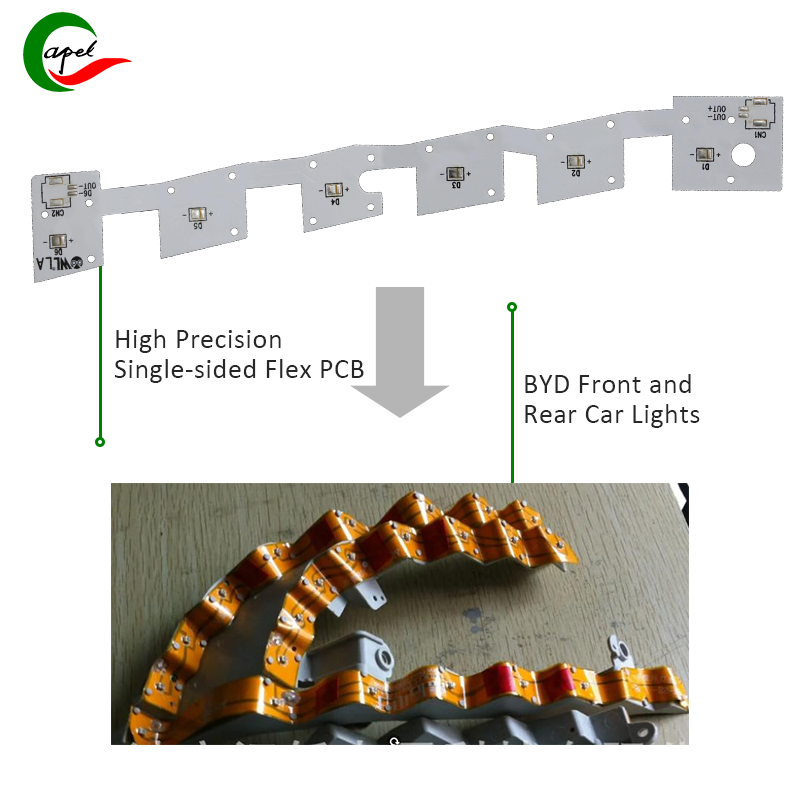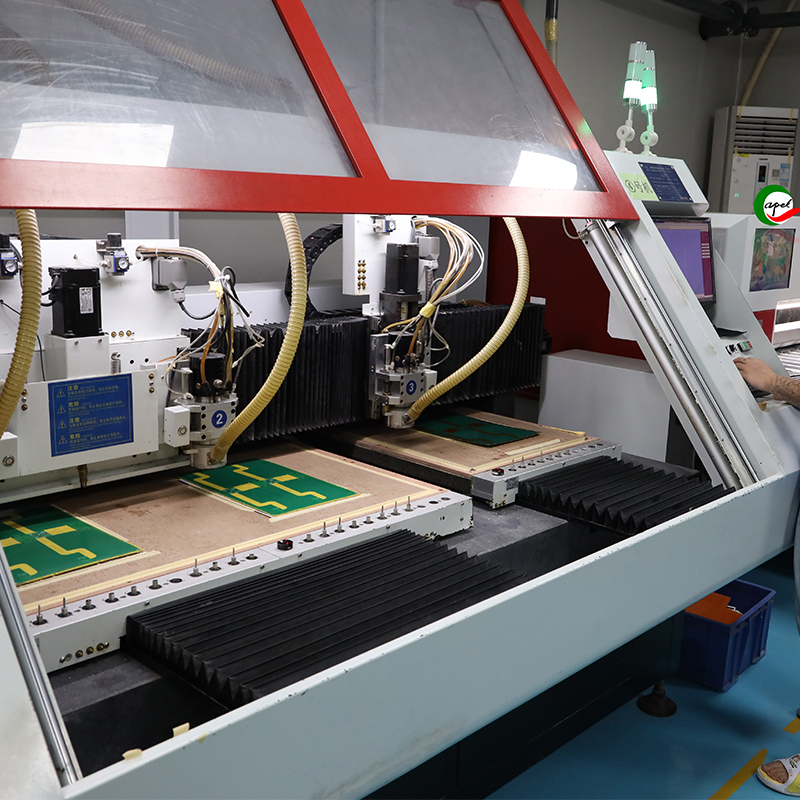Dive into the world of car lights and explore the PCB technology behind them:
Are you fascinated by the alluring glow of car lights? Have you ever wondered about the technology behind these amazing wonders? Now is the time to unravel the magic of single-sided flex PCBs and their role in enhancing the performance of automotive front and rear lights. In this blog, we will provide an in-depth analysis of single-sided flexible PCBs, their characteristics and how they can be perfectly integrated into the lighting system of a vehicle, especially a BYD car.
Basic Concepts, Design Considerations, Advantages And Applications of Single-Sided Flexible Printed Circuit Boards:
Before we dive in, let’s go over the basics. Single-sided flexible PCBs, also known as single-sided flexible printed circuit boards, are a popular choice for many applications due to their flexibility and compact design. They are made of thin polyimide or mylar coated with a thin layer of copper on one side. This layer of copper acts as a conductive trace, allowing electrical signals to flow in the circuit.
When designing a single-sided flex PCB, engineers must consider factors such as the application’s mechanical requirements, desired electrical performance, and manufacturing process. Additionally, proper insulating and protective coatings can be applied to the circuits to enhance durability and reliability.
The flexibility of single-sided flex PCBs enables complex and compact designs, making them ideal for space-constrained applications where traditional rigid PCBs cannot. This flexibility also allows the PCB to be bent, folded or twisted without damaging the circuitry, making it suitable for applications requiring resistance to movement or vibration.
Single-sided flex PCBs are commonly used in various industries including automotive, aerospace, medical devices, consumer electronics, and more. Their flexibility and compact design make them suitable for applications such as wearables, mobile phones, cameras, sensors and other electronic devices where size, weight and flexibility are important considerations.
Ensure Efficient Power Transfer And Signal Integrity With Selected Linewidths And Spaces:
A key factor in ensuring optimal conductivity of single-sided flex PCBs is line width and line spacing. Linewidth refers to the thickness or width of a conductive trace on a PCB, while pitch refers to the distance between adjacent traces. Maintaining proper trace width and spacing is critical to enhancing connectivity and minimizing signal interference on these boards.
For this application of Capel’s single-sided flex PCB, a combination of line width and space for best conductivity is 1.8 mm and 0.5 mm, respectively. These values are carefully determined based on factors such as circuit type, current carrying capability, and signal integrity requirements for a particular application.
The 1.8mm line width provides enough current carrying capacity to ensure efficient power transfer across the single-sided flexible PCB. It enables the PCB to handle the required electrical load while minimizing resistive losses. This is especially important in applications with relatively high power requirements, such as motor control applications or power supply circuits.
On the other hand, the 0.5mm pitch provides the necessary clearance between traces to prevent signal interference and crosstalk. It helps minimize electrical noise and the possibility of signal cross-contamination, ensuring reliable data transmission and maintaining optimal signal integrity. This is critical for applications involving high-frequency signals, such as wireless communication equipment or high-speed digital circuits.
By maintaining a balanced combination of line width and line spacing, single-sided flex PCBs can achieve optimal electrical conductivity for efficient and reliable electrical connections. This not only improves the performance of electronic devices, but also ensures their longevity and durability.
In conclusion, the selection of line width and line spacing is the key factor to ensure the best conductivity of single-sided flexible PCB. The 1.8mm line width provides sufficient current-carrying capacity, and the 0.5mm line spacing helps reduce signal interference and crosstalk. Careful consideration of these parameters ensures that electronic equipment operates reliably and efficiently in a variety of applications.
Low Profile And Flexibility Advantages Of Single-Sided Flex PCB For Automotive Applications:
The single-sided flex PCB board is 0.15mm thick, and the total thickness is 1.15mm. This thin profile makes them lightweight, which is beneficial for automotive applications where weight reduction is often a priority. The flexibility of these PCBs allows them to be adapted to different shapes and layouts, enabling efficient use of space in the vehicle interior.
Furthermore, the 50μm film thickness increases the durability and resilience of these PCBs. The film acts as a protective layer, protecting the circuitry from potential environmental challenges such as dust, moisture, vibration and temperature fluctuations. Increased resilience ensures PCB longevity and reliability in harsh automotive environments.
In automotive applications, where PCBs are exposed to harsh conditions such as temperature changes, vibration, and electromagnetic interference, thin-film coatings add an extra layer of protection to the circuitry. It helps prevent damage to copper traces and components, ensuring the PCB can withstand the challenging operating environment of the vehicle.
The durability and flexibility of these single-sided flex PCBs make them ideal for a variety of automotive applications. They are used in control systems, sensors, lighting, audio systems and other electronic components in the car. The lightweight nature of these PCBs also contributes to improved fuel efficiency and overall weight reduction, key factors in modern automotive design.
Overall, the combination of slim profile, lightweight design, and protective film coating make these single-sided flex PCBs ideal for automotive applications. They are durable, resilient and flexible, ensuring reliable performance and long life in challenging environments.
The Importance of Using High Thermal Conductivity PCBs in Automotive Lighting Systems to Prevent Heat-Related Issues:
Thermal performance is a critical factor in electronic systems, especially in applications that generate a lot of heat, such as automotive lighting systems. In this context, single-sided flex PCBs are known for their excellent thermal performance.
A key factor in the superior thermal performance of single-sided flex PCBs is their thermal conductivity. This application of Capel’s PCBs are specified with a thermal conductivity of 3.00, which indicates their ability to transfer heat efficiently.
Higher thermal conductivity values indicate that the PCB material can effectively conduct and dissipate heat away from heat-generating components. By doing so, it helps maintain the optimum operating temperature of delicate lighting components, preventing any damage from excessive heat build-up.
Automotive lighting systems, especially those using LED technology, generate a lot of heat during operation. For example, LED headlights generate heat as they consume electricity. Without proper heat dissipation, this heat can cause performance degradation, premature component failure, and even safety issues.
By incorporating single-sided flexible PCBs with high thermal conductivity into automotive lighting systems, manufacturers can ensure efficient heat dissipation. Therefore, these PCBs play a vital role in preventing heat-related damage and maintaining the overall reliability and longevity of the lighting system.
Additionally, the flexibility of single-sided flex PCBs enables them to be shaped and designed to meet the specific requirements of automotive lighting systems. This flexibility ensures efficient heat transfer even in confined spaces or complex wiring layouts. By conforming to the system design, a single-sided flex PCB can maximize cooling efficiency and thermal management.
These Capel’s PCBs have a thermal conductivity of 3.00 to efficiently dissipate heat and protect delicate lighting components. Their application in automotive lighting systems is critical to ensure long life and reliability by preventing damage from overheating.
How Single-Sided Flexible PCBs Can Enhance Their Durability, Corrosion Resistance And Performance-Enhancing :
ENIG Finish: The PCB has an ENIG (Electroless Nickel Immersion Gold) finish with a thickness of 2-3uin (micro inches). ENIG is a popular surface treatment in the electronics industry due to its excellent corrosion resistance and solderability. The thin, uniform gold layer provides a protective barrier against oxidation, ensuring PCB durability and preventing potential performance degradation over time.
1OZ Copper Thickness: The PCB has a 1OZ (ounce) copper thickness. This refers to a layer of copper weighing 1 ounce per square foot. The thicker the copper layer, the lower the resistance and the better the conductivity. The 1OZ copper thickness indicates that a single-sided flex PCB can effectively conduct electrical signals and power, minimizing voltage drop and signal attenuation that may occur with thinner copper layers.
Rigidity and integration with aluminum plate: The integration of single-sided flex PCB with 1.0mm aluminum plate contributes to its rigidity. The aluminum plate is drawn and bonded with thermally conductive glue, which enhances the overall structure of the PCB. The stiffness provided by the integration with the aluminum plate is critical to maintaining the shape of the PCB and preventing excessive bending or flexing. This is especially important for applications where the PCB may be subjected to mechanical stress or frequent bending, such as wearable devices or flexible displays.
Better heat dissipation: The aluminum sheet bonded with thermal conductive adhesive not only strengthens the structure, but also has better heat dissipation effect. Aluminum is an excellent conductor of heat, so integrating it into a PCB assembly can effectively transfer heat away from heat-generating components. The enhanced heat dissipation capability of single-sided flex PCBs is critical for applications where thermal management is critical, such as power electronics, LED lighting, or automotive systems. It helps prevent overheating and ensures reliable operation of components, ultimately improving the overall performance and reliability of the PCB.
ENIG 2-3uin surface treatment, 1OZ copper thickness, integration with 1.0mm aluminum plate, and use of thermally conductive adhesive help to enhance durability, corrosion resistance, electrical conductivity, stiffness, and heat dissipation. Single-sided flexible PCB. These features make it suitable for a variety of applications requiring reliable and robust performance in challenging environments.
Explore The Technical Advantages Of Single-Sided Flexible PCBs In Automotive Lighting Systems:
Now that we have understood the characteristics of single-sided flexible PCBs, let’s explore their application in front and rear lights of cars, especially BYD cars. BYD, a leading electric vehicle maker, has been at the forefront of incorporating cutting-edge technology into its vehicles. The integration of single-sided flexible PCB in BYD’s automotive lighting system is definitely a game-changer.
Car front and rear lights play a vital role in ensuring road safety. These lights enhance visibility, allowing drivers to sense their surroundings and react accordingly. The application of single-sided flexible PCBs in these lamps has revolutionized the automotive industry by enhancing the performance and functionality of the lighting system.
The lightweight and flexible nature of single-sided flex PCBs enables engineers to design compact lighting systems without compromising functionality. By taking advantage of these PCB space-saving features, BYD cars are equipped with stylish and elegant taillights and headlights. The result is not only enhanced aesthetics but also improved road safety.
In addition, the excellent thermal conductivity of the single-sided flexible PCB helps to extend the lifetime and efficiency of the lighting system. These PCBs efficiently dissipate the heat generated by the bulbs, preventing any overheating issues. This in turn ensures that the front and rear lights remain functional for a long time, even under demanding conditions.
The integration of a single-sided flexible PCB also enables seamless control and customization of lighting effects. Engineers can program different lighting patterns and sequences to create the unique styling of BYD vehicles. This customization adds a personal touch to the vehicles, making them stand out on the road.
Summary:
In summary, the analysis of single-sided flexible PCBs for automotive front and rear light applications reveals the important role they play in enhancing the performance and functionality of automotive lighting systems. They are lightweight, flexible, have excellent thermal conductivity, and are integrated with surface treatments and aluminum panels, making them ideal for BYD cars and other automotive applications.
The magic behind the mesmerizing glow of automotive lights lies in the impeccable design and integration of the single-sided flex PCB. These printed circuit boards enable engineers to push the boundaries of innovation to bring safer, more stylish vehicles to the market. Whether you’re strolling the city streets or embarking on a long road trip, you can trust the superior performance of Capel’s ’ flexible PCB boards to show you the way.
Post time: Aug-19-2023
Back








